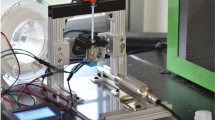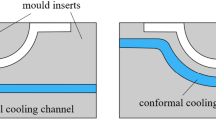The work addresses the manufacturing of capillary tubes, involving drawing on a long movable mandrel and their subsequent reeling along the outer diameter in order to extract the mandrel, resulting in finished tubes of the desired quality. The two-stage finite element modeling (FEM) included varying key parameters such as tube reduction and clearance between the tube and the mandrel over a wide range. At the first stage, the permissible reduction was determined with a limit on the tolerance for the outer diameter. At the second stage, the occurrence of tube faceting was studied.






Similar content being viewed by others
References
GOST (State Standard) 14162-79, Small Steel Tubes (Capillary). Technical Specifications [in Russian], Izd. Standartov, Moscow (2004).
GOST (State Standard) 2624-2016, Capillary Copper and Brass Tubes. Technical Specifications [in Russian], Standardinform, Moscow (2017).
DIN EN 12451-2012. Copper and Copper Alloys. Round, Seamless Tubes for Heat Exchangers.
P. Jadhav, A. Sahu, and S. Ballal, “Numerical study on the straight, helical and spiral capillary tube for the \({{\text{CO}}}_{2}\) refrigerant,” Sci. Tech. J. Inf. Technol. Mech. Opt., 22, 804–811 (2022).
R. A. Yuryev, V. A. Dudko, and G. P. Selyanin, “Development of capillary tube manufacturing technology for medical syringes,” Stal’, No. 3, 35–38 (2019).
V. V. Kashirshev, “Influence of the quality of the inner surface on the performance characteristics of capillary tubes made of chromium-nickel steel,” in: Functs. Nanomat. Vysokoch. Veshch., Collection of 8th International Conference Proceedings with Workshop for Young People, IMET RAS (2020), pp. 62–64.
Z. I. Pertsikov, Draw Benches [in Russian], Metallurgiya, Moscow (1986).
S.P. Burkin, et al., Patent RF 76259, IPC AT 21 FROM 3/00, Pervouralsky Novotrubny Zavod OJSC, Byul. No. 26 (2008).
R. A. Okulov and N. V. Semenova, “Modeling the drawing of square-cross-section pipes/tubes made from various materials,” Metallurgist, 65, 571–577 (2021).
R. A. Okulov and N. V. Semenova, “Development of a mathematical model to describe the effect of wall thickness on the intensity of deformation during form drawing,” Vestn. Meshinostr., No. 6, 49–52 (2020).
M. Hatala, F. Botko, J. Peterka, P. Bella, and P. Radic, “Evaluation of strain in cold drawing of tubes with internally shaped surface,” Mater. Today: Proc., 22, 287–292 (2020).
P. Bella, R. Durcik, M. Ridzon, and L. Parilak, “Numerical simulation of cold drawing of steel tubes with straight internal rifling,” Procedia Manuf., 15, 320–326 (2018).
F. Boutenel, M. Delhomme, V. Velay, and R. Boman, “Finite element modeling of cold drawing for high-precision tubes,” CR MECANIQUE, 346, 665–677 (2018).
G. Shu, X. Jin, Y. Zhang, Y. Gu, B. Zheng, and Q. Jiang, “Experimental and numerical study of cold-drawn duplex stainless steel square tube columns,” J. Constr. Steel Res., 156, 155–166 (2019).
P. Bella, P. Bucek, M. Ridzon, M. Mojzis, and L. Parilak, “On numerical modeling of multi-rifled tube drawing,” Procedia Eng., 207, 2382–2387 (2017).
R. A. Okulov, S. V. Parshin, and V. A. Spiridonov, “Effectiveness of additional loading in drawing noncircular pipe,” Russ. Eng. Res., 34, No. 8, 509–511 (2014).
A. P. Chekmarev and V. M. Druyan, Theory of Pipe Production [in Russian], Moscow, Metallurgy (1976).
R. A. Okulov and S. V. Parshin, “Comparative analysis of the use of different types of dies to draw tubes,” Metallurgist, 59, No. 1/2, 156–158 (2015).
Author information
Authors and Affiliations
Corresponding author
Additional information
Translated from Metallurg, Vol. 67, No. 10, pp. 89–92, October, 2023. Russian DOI https://doi.org/10.52351/00260827_2023_10_89.
Rights and permissions
Springer Nature or its licensor (e.g. a society or other partner) holds exclusive rights to this article under a publishing agreement with the author(s) or other rightsholder(s); author self-archiving of the accepted manuscript version of this article is solely governed by the terms of such publishing agreement and applicable law.
About this article
Cite this article
Parshin, S.V., Khlebnikov, P.S., Fedulov, A.A. et al. Modeling Reeling Process of Capillary Tubes Following Mandrel Drawing. Metallurgist 67, 1532–1537 (2024). https://doi.org/10.1007/s11015-024-01646-0
Received:
Revised:
Accepted:
Published:
Issue Date:
DOI: https://doi.org/10.1007/s11015-024-01646-0




